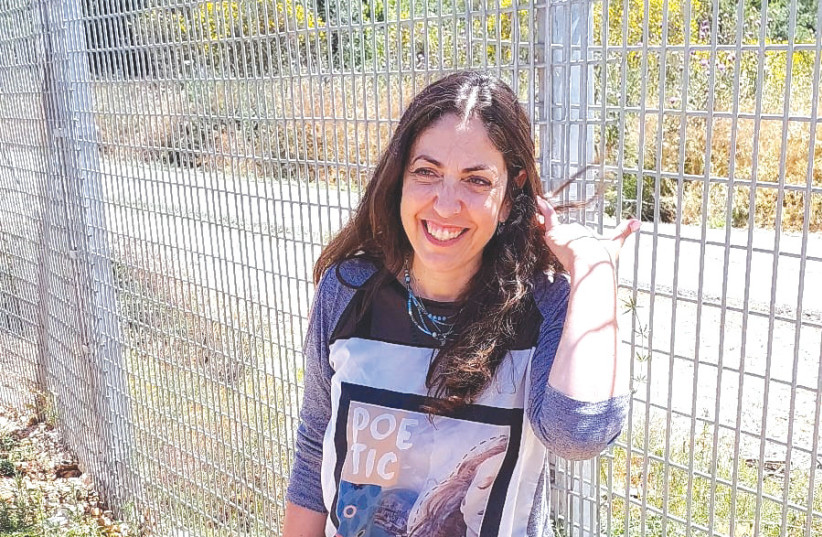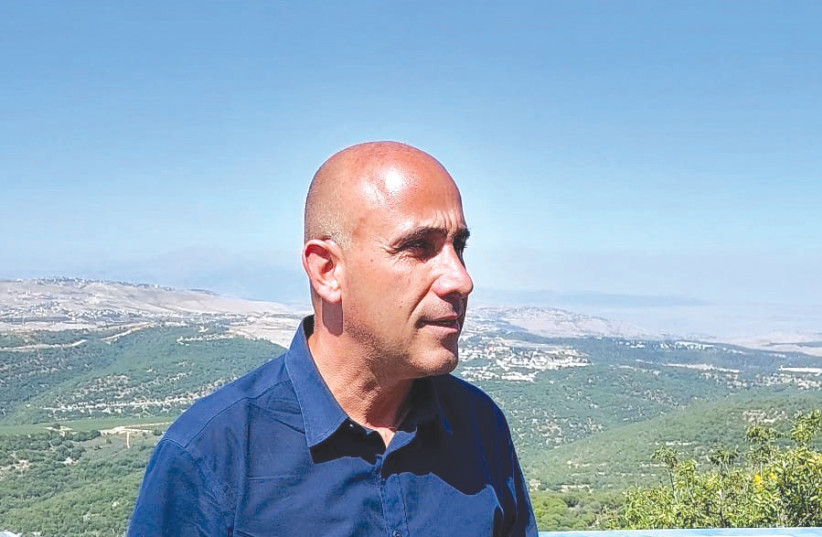Tensions on northern border: Will there be another war?
A squad of helmeted soldiers, weapons drawn and in full battle regalia, ran down a sidewalk in Moshav Betzet on Wednesday – in front of a preschool full of kids and directly across the street from where twisted pieces of tin and aluminum, as well as oddly colored earth, indicate where a rocket hit.
A drone overhead emitted a humming noise.
The soldiers and drone are part of a massive IDF exercise called Firm Hand, one of the largest IDF exercises ever, simulating a multifront war. The tin, aluminum and discolored earth testify to a Hamas rocket, fired a few kilometers away in Lebanon, that struck a warehouse in March.
The running soldiers and UAV are practicing; the remnants where the rocket hit show why.
Eliezer Amsalem, head of the Security Department in the Ma’aleh Yosef Regional Council, which includes 22 Upper Galilee communities near the Lebanese border, said there is more concern than there has been in years about a dangerous escalation or a major war in the north. The reasons are many, he said: Iranian interests, a misperception that Israeli is weak, internal Lebanese problems, and pressure from various corners on Hezbollah to act.
 SARIT ZEHAVI (credit: HERB KEINON)
SARIT ZEHAVI (credit: HERB KEINON)“In the final analysis,” he said, “a terrorist organization’s purpose is to engage in terrorism. It has no reason to exist if it doesn’t do that.”
Hezbollah tried to carry out a major terrorist attack in Israel on March 13 when a terrorist with an explosive vest and a Claymore mine of the type common in Lebanon infiltrated into Israel and unsuccessfully tried to carry out a major attack at the Megiddo junction.
That operation, during which one Israeli-Arab was seriously wounded, set off a cascade of alarm bells, since it was the first terrorist intrusion from Lebanon since 2006, when the abduction of Ehud Goldwasser and Eldad Regev near Zar’it triggered the Second Lebanon War. Then, three weeks later, on April 6, a barrage of rockets – 34 in all – was fired from Lebanon, five of which were not intercepted.
Jitters among northern residents
Jitters among northern residents, therefore, are not unfounded – though those jitters are offset by having lived in the shadow of Hezbollah for decades and by great confidence in the IDF’s protective capabilities.
Among Ma’aleh Yosef’s 22 communities is Zar’it, a community of some 250 people. On the outer rim of the community is a large mushroom plant located between the existing security fence and a concrete wall the IDF is rapidly building along the entire border. According to Sarit Zehavi, a reserve Military Intelligence officer who now heads the Alma Research and Education Center focusing on security challenges in the north, work on the wall began in 2017. About 30% of it has been built, though its construction has been stepped up considerably in recent weeks, she said.
The view from the mushroom plant, just a few meters from a section of the wall that is already built, is startling.
To the west is a tall black watchtower, with a Hezbollah fighter watching through his binoculars the Israelis watching him. To the east is a UNIFIL position, some homes, and a white building that figured prominently in the video of a recent Hezbollah exercise simulating the kidnapping of IDF soldiers.
Underneath the white building, clear to binocular-aided eyes, are two posters – one of Hezbollah’s leader, Hassan Nasrallah, and the other of a former head of the Islamic Revolutionary Guard Corps’ Quds Force, Qasem Soleimani, killed by the Americans in 2020. And to the west of that is a water tower decorated to appear like al-Aqsa Mosque.
With Hezbollah, according to Alma’s estimation, in possession of some 145,000 mortars – which can be fired directly into the living rooms of homes in communities along the border, and to which Iron Dome does not provide an answer – 65,000 short-range rockets and missiles, 5,000 long- and mid-range missiles, 2,000 UAVs, and hundreds of advanced conventional weapons, such as precision-guided missiles, a concrete wall seems already obsolete. The wall can’t prevent this deadly arsenal from doing damage.
But what it can do is make incursions into one of the Israeli communities along the border more difficult, something Hezbollah has publicly been practicing. According to Amsalem, the wall, coupled with technology to detect tunnels, “gives people a sense of security.”
This is why its construction is being sped up now – at one point outside of Zar’it, construction on the wall is taking place just a few meters from a Hezbollah watchtower – since it provides a sense of security at a time when recent talk of escalation and war is doing the exact opposite.
The Megiddo incursion and Hamas rockets from Lebanon have been accompanied by Nasrallah’s belligerent rhetoric about Israel’s inevitable disappearance and the weakness of its society. This has, in turn, been met with stern warnings by senior Israeli officials of a possible miscalculation.
Ten days ago, the head of the Military Intelligence Directorate, Mag.-Gen. Aharon Haliva, warned that Hezbollah was “close to making a mistake” that would trigger a regional war, saying that “the chances of an escalation that could deteriorate into war is not low.”
Haliva said that the Megiddo incident was not a “one-off,” and that the Hezbollah head is “close to making a mistake that could plunge the region into a big war. He is close to making this mistake from Lebanon or Syria.”
National Security Adviser Tzachi Hanegbi, speaking this week on Army Radio, said that with these words, Haliva was issuing Nasrallah a “yellow” (warning) card. He said that while Nasrallah has behaved in a restrained manner on the border since the Second Lebanon War, in recent weeks Israel is detecting a change in Hezbollah’s actions, as evidenced by the Megiddo junction attack and “other actions.”
According to Hanegbi, this is what Israel is saying to Hezbollah: “You should not think that because we have protests and disagreements, that we are weak. If you forgot Israel’s strength, you should look at what happened in Gaza [during Operation Shield and Arrow], where, in a matter of days, we decapitated the Islamic Jihad leadership and then decapitated the leaders who were to replace them.”
Hezbollah, Hanegbi said, needs to “go back to thinking more logically, because if not, they will pay a heavy price. That is the message. We are not interested in a war; we believe the other side is not either, but sometimes, because of a miscalculation, you are dragged into a war.”
The recent operation in Gaza, Zehavi indicated to a small group of journalists she met with on a tour of the region sponsored by Media Central, might go a certain distance toward preventing a miscalculation.
 AMIR AVIVI at the Mount Adir lookout into southern Lebanon (credit: HERB KEINON)
AMIR AVIVI at the Mount Adir lookout into southern Lebanon (credit: HERB KEINON)Why? “Because the Iranians were pushing for more,” she said. “They were dreaming of other groups joining in the fighting – Hamas and Hezbollah. But nobody joined in. This is encouraging because there is a gap between what the Iranians want to do and what they have succeeded in doing – at least at this point.”
Nasrallah had become emboldened because of several factors, she said, including the outcome of the wars in Syria and Yemen, the crisis in the relationship between the US and Saudi Arabia, the fact that Iran was never punished for bringing its nuclear program to military levels, and the level of internal strife inside Israel.
According to Zehavi, this led to a situation reassessment in Tehran and Beirut, where the conclusion was, “Hmm, maybe if I escalate the situation on Israel’s northern border, nothing will happen to me. It is a different management assessment than we have gotten used to over the last 16 years.”
Nevertheless, she currently sees two scenarios that may develop in the north.
The first is continued Iran-sponsored escalation on various fronts, though stopping short of a full-scale war, in order to just continue to wear down Israel – and this escalation will increase as long as Iran and Hezbollah believe there is no price to pay.
The second scenario is more apocalyptic and concerns Iran and its nuclear program.
“Another scenario, whose probability I don’t know but also one I can’t overrule, is that Iran and Hezbollah are interested in war. The reason is that they know that if there is a war, the IDF will be completely invested in the conflict in the north rather than somewhere in the nuclear sites in Iran. A war here would buy them some time to finish their nuclear project. This is an option, and I can’t rule out that this is a calculation the Iranians are making.”
Another former senior security official, Amir Avivi – a retired brigadier-general and head of a right-leaning organization of ex-security officials called Israel Defense and Security Forum – also mentioned two scenarios, while speaking from a lookout into southern Lebanon from Mount Adir. But his scenarios had to do with how such a war might start.
The first scenario he called the Six Day War option, and the other the Yom Kippur option. In the first case, Israel preempts against Hezbollah, and in the second, Hezbollah launches a surprise rocket, missile and drone attack against Israel.
The Iranians, he said, are factoring the following consideration into their calculation: wanting to keep their proxies – Hezbollah and Hamas – intact “for a possibility of an Israeli attack on Iran.
“They don’t want to waste all the capabilities that they built up for so long,” he said. “The Iranians understand that if we go to war with Hezbollah, we will have to destroy their capabilities. Then the question is what will happen the day after to Iran, because if we went to war and destroyed Hezbollah’s capabilities, then it will be a much easier decision to go and attack Iran, since they won’t have Hezbollah to deploy against us. So the Iranians are very careful. They are really not motivated to let Hezbollah start a war with us.”
From an Israeli perspective, he said, it would not necessarily make sense to act preemptively in Lebanon, if this does not include Iran. So even though he said the conditions for a major war in the north exist, neither side seems very motivated to start a war that would have a strong Iranian element involved.
But, as Hanegbi said, sometimes sides are dragged into a war they don’t want, because of a miscalculation. And it is precisely that scenario – a multifront regional war caused by a miscalculation – that the IDF’s massive Firm Hand exercise is designed to deal with.





Comments are closed.